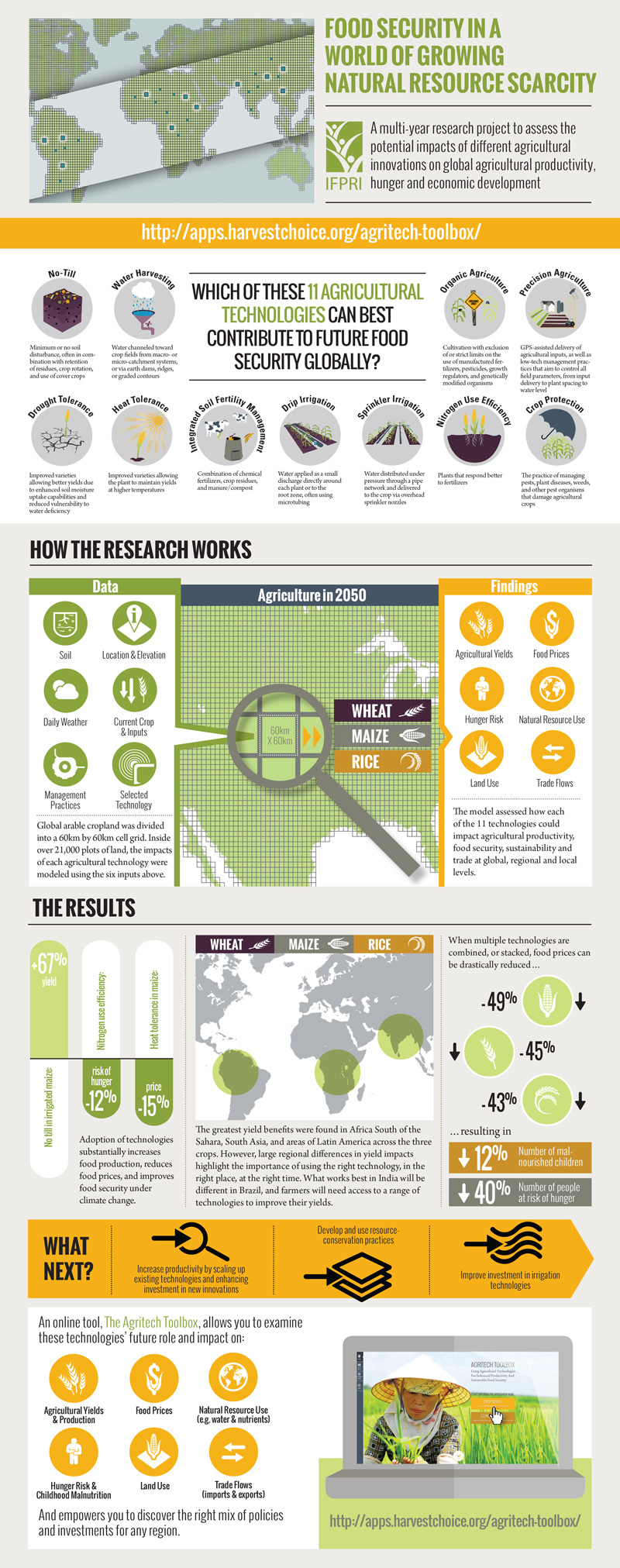A wealth of technologies is now at our disposal for boosting yields of the world’s key staple crops, in order to face the large demands on our food supplies by 2050. But how can we measure which ones will be most effective, when, and where? Which combinations of technologies will have the largest impact? Until now, policymakers have struggled to make informed decisions on how to boost productivity in their regions in the most sustainable way.
The book “Food Security in A World of Natural Resource Scarcity: The Role of Agricultural Technologies” launched today by the International Food Policy Research Institute (IFPRI) seeks to answer these questions. This ground breaking study divides the world’s arable land into a grid of 60 kilometre by 60 kilometre cells and shows how eleven different agricultural innovations might affect maize, wheat and rice yields by 2050 under climate change conditions. Through linking this yield assessment with a global economic model, the book also reports on technology impacts on food prices, trade and food security.
THE TECHNOLOGIES
The report reviews 11 agricultural technologies ranging from traditional low-tech practices to more advanced technologies:
- No-till – minimum or no soil disturbance, often in combination with retention of residues, crop rotation, and use of cover crops
- Integrated soil fertility management – a combination of chemical fertilizers, crop residues, and manure/compost
- Precision agriculture – GPS-assisted delivery of agricultural inputs, as well as low-tech management practices that aim to control all field parameters, from input delivery to plant spacing to water level
- Organic agriculture – cultivation with exclusion of or strict limits on the use of manufactured fertilizers, pesticides, growth regulators, and genetically modified organisms
- Water harvesting – water channelled toward crop fields from macro- or micro-catchment systems, or via earth dams, ridges, or graded contours
- Drip irrigation – water applied as a small discharge directly around each plant or to the root zone, often using microtubing
- Sprinkler irrigation – water distributed under pressure through a pipe network and delivered to the crop via overhead sprinkler nozzles
- Heat tolerance – improved varieties allowing the plant to maintain yields at higher temperatures
- Drought tolerance – improved varieties allowing better yields due to enhanced soil moisture uptake capabilities and reduced vulnerability to water deficiency
- Nitrogen-use efficiency – plants that respond better to fertilizers
- Crop protection – the practice of managing pests, plant diseases, weeds, and other pest organisms that damage agricultural crops
HUGE POTENTIAL FOR YIELD GROWTH AND HUNGER REDUCTION
The book finds that widespread adoption of these technologies can significantly reduce global hunger by 2050. The number of food-insecure people in developing countries in 2050 could be reduced by 12 percent if nitrogen use efficiency technologies were successfully developed and adopted, by 9 percent if no-till is adopted more aggressively and by 8 percent with widespread adoption of heat tolerance and precision agriculture.
The book also finds that the use of no-till on a global scale can increase biophysical maize and wheat yields by about 30 percent, with small variations depending on climate change scenario. On a regional scale, it could increase maize yields in Sub-Saharan Africa by more than 30 percent in rain-fed environments and more than 100 percent in irrigated environments.
On a global scale, biophysical yield impacts for crop protection products for disease, insects and weeds are close to 10 percent each across the three crops; and will constitute an important tool to address likely growing pest pressures under both intensification and climate change.
Irrigation water savings on fields under drip irrigation are 24 to 27 percent, depending on crop and climate change scenario, much higher than water savings for sprinkler irrigation systems calculated at 11 to 12 percent.
DIFFERENT REGIONS REQUIRE DIFFERENT TECHNOLOGIES
Agricultural technology impacts differ substantially by region and within regions by country. For example, when the impact of drought tolerance is tested globally, it seems to have a low impact, as drought only affects some regions in some seasons and years. Yet at the right time in the right region, impacts can be significant. Detailed drought yield assessment in the United States and China, two of the world’s largest maize producers shows yield benefits of up to 13 percent for this technology and crop.
Given that the study generated vast datasets on these technologies and crops for all countries in the world under varying climate change scenarios, an online tool has been developed to allow policymakers and researchers hands-on access to the results.
COMBINED TECHNOLOGIES FOR MAXIMUM IMPACT
Combining multiple technologies (or ‘stacking’ them) can have an even greater impact. Adopting the three types of crop protection (weed, disease and insects) together could reduce the number of food-insecure people by close to 9 percent.
Moreover, if all technologies with positive yield impacts were adopted together for these three crops, prices of maize, wheat and rice could be reduced by 49 percent, 45 percent and 43 percent, respectively. This is equivalent to reducing the number of people at risk of hunger by 40 percent.
This first of its kind study can truly equip decision makers to take action now to secure a sustainable food supply for a healthy planet in 2050.
Find out more by visiting www.ifpri.org/publication/food-security-world-natural-resource-scarcity




